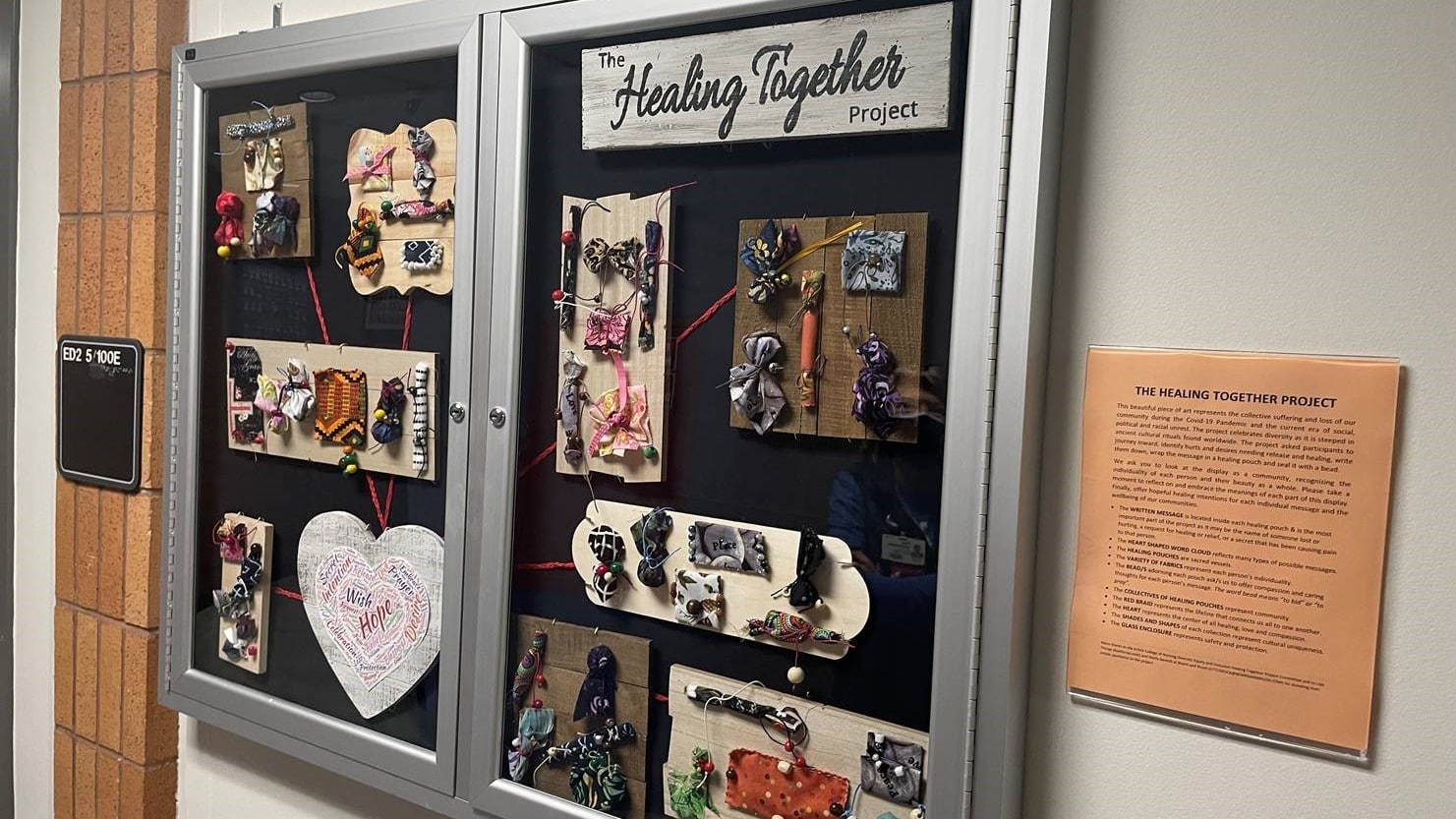View Larger Image

The Healing Together board is displayed in the College of Nursing.
Healing Together Project Inspires Hope for the Future
| March 17, 2022 | When Pamela de Gravelles saw the “Beaded Prayers Project” at Crystal Bridges Museum of American Art in Bentonville, she saw just how art could represent the collective suffering and loss of community during the COVID-19 pandemic.
The exhibit, started by artist Sonya Clark, was a display of 5,000 pouches, each consisting of a small piece of paper containing a note about pain, grief or hope for the future, wrapped in a decorative swatch of fabric. The bundle is sewn closed and adorned with beads. The intent is to release the pain and begin healing.
The pouches were inspired by amulet traditions in African culture where messages of hope were sealed inside cloth or leather. Beads are used because of their association with prayer beads, and because they are known in cultures worldwide as sacred ornaments. The Old English word for bead is “biddan,” which means “to pray.”
De Gravelles, Ph.D., RN, a clinical associate professor at the University of Arkansas for Medical Sciences (UAMS) College of Nursing, immediately knew she had to recreate the project at UAMS.
“You could feel people’s grief and pain through the display,” she said.
Although lockdowns and restrictions have eased since 2020, the stress has not let up for hospitals and clinics as new variants continue to tax health systems. As COVID-19 continues to stretch health care workers beyond their limits, de Gravelles saw the healing pouches as a way for those workers to display their worries, fears and hopes as works of art.
“I wondered who is healing the healers,” she said. “I felt the project could ease the silent suffering amongst caregivers.”
She started the Healing Together project in May 2021 within the College of Nursing. The project asked participants to journey inward, identify hurts and desires needing release and healing, write them down, wrap the message in a healing pouch and seal it with a bead. Each person picked their own materials to make their pouch, signifying their unique struggles. Some even chose to use a cloth face mask for the fabric portion, driving home just how taxing the pandemic has been.
Although the messages contained in the pouch are hidden, participants said having a physical representation of their pain helped them begin the healing process.
In keeping with African amulet traditions, it is the presence of the word, not the ability to read it, that yields their power. The cloth pouch acts as a veil elevating the contents to an intangible and metaphysical realm.
“Many people enjoy the sense of mindfulness the project brings, and the sense that they created something special personally,” de Gravelles said.
Participants were able to get together to create their healing pouches, creating a sense of community and allowing them to see they were not alone.
Kimberly Stickley, DNP, APRN, a clinical instructor in the College of Nursing, created a pouch and led a mindfulness practice for the group.
“It was very touching for me, and I cried as I realized the commonality of all of us in the College of Nursing,” she said. “We all know someone who has suffered greatly due to COVID.”
Afterwards, the pouches were collected and pinned on a board in the College of Nursing, creating a quilt-like display. The board is enclosed in glass, representing safety and protection. Each piece of art is connected by a red string representing lifelines leading back to a heart in the center of the board. The display recognizes the collective suffering of health care workers, allowing all who see it to embrace and support one another.
There are 50 pouches in the display, each one unique in appearance, symbolizing the diversity of the participants. The project represents a collective sense of grief while showing that no one is alone in their pain.
Stickley said the display is deeply moving to look at.
“We all had either faith in a higher power or a wish for things to get better. We could all join in placing our prayers, thoughts, wishes and intentions on the board,” she said. “It reminds me that we all hurt, and we will all heal together.”
De Gravelles said she hopes to see the project expand across UAMS. She plans to extend the opportunity to create pouches, believing the creation of the art and more displays will provide hope, comfort and a sense of community.
“I would really love to see this spread, and that everyone who sees it will know they are not alone,” she said.